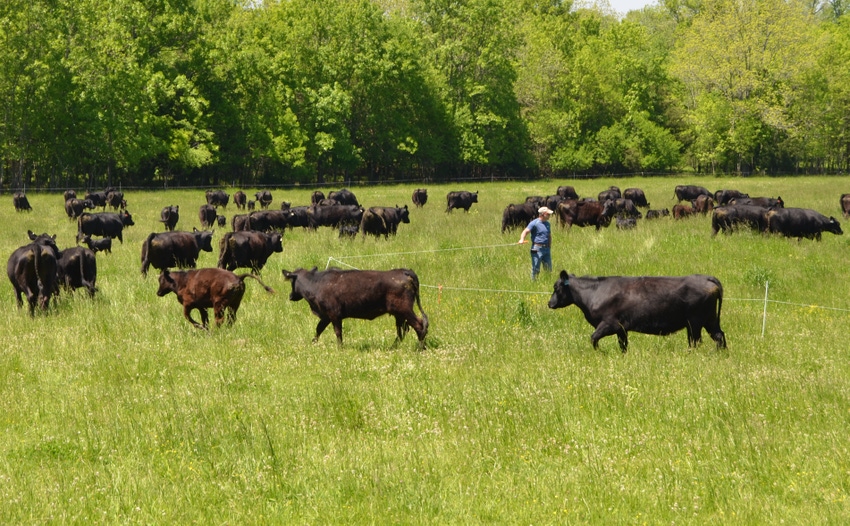
At the end of August, the amount of plant growth and biomass in front of and several weeks behind our cattle was phenomenal.
Despite droughts in the West, we had plenty of rain, humidity, fogs, sunshine, and even a few cool nights and moderate days. I was seeing lots of cool-season plants breaking dormancy and making growth.
Soil and the huge community that keeps house on and below the soil surface love moisture and air and sweet temperatures (65-80 degrees). Bacteria and protozoa from cattle dung favor the grass we need to grow in high tonnage. Calcium in large amounts and phosphorus in goodly amounts, plus some potassium and magnesium and a little of several trace minerals are needed for plants to be truly nutrient dense.
Healthy soil, covered with healthy plants, self-harvested by well-managed cattle yields profitable, healthy, healing beef. This is our method and market.
In days gone by, ruminants such as cattle are really good at recycling the entirety or near entirety of the land when surrounded by their “boss”, the big predators. North America’s major big predator probably was the wolf. In the east the major big ruminants were the elk and buffalo. The herds were not allowed to spread for more than a few weeks annually. This happened while the “bad guys” were whelping and nursing pups in April and May. The herd would spread a little and quickly calve a month or so later after having time to put several miles between themselves and their predators.
The wolf is mostly gone and a few of us have replaced the predator with electric fence technology and management. This new predator has given us the ability to mimic the natural model.
Walt Davis, in his book How Not to Go Broke Ranching lists what happens to several minerals in a grazing operation as opposed to a haying operation. There is a big difference, with well-managed grazing the easy victor in this contest. I have never seen a haying operation that remained profitable long-term unless they had a near free and endless source of inputs that had been predigested. Broiler litter and municipal sludge would be two examples if they are spread for free.
A 1,000-pound steer harvested off a grazing operation at 24 months of age removes the following:
820 pounds of water (40 cents)
Nine pounds of calcium (9 cents)
Five pounds of phosphorus ($3)
Four pounds of potassium ($2.40)
Two to three pounds magnesium, salt, selenium, zinc, iodine, copper, iron, sulfur, boron, and other trace minerals ($2)
Total removal is about 20 pounds of minerals and trace minerals with a dollar value of about $7.50. The vast majority is calcium, phosphorus and potassium.
Besides those common minerals, close to 150 pounds of carbon and nitrogen are included in the steer and are available almost free of charge from the air if we allow the natural model to function at a high level of efficiency.
Hay, on the other hand, is much more consumptive. Harvesting and removing 6,000 pounds of quality hay to grow a 600-pound steer to 1,000 pounds off location removes the following minerals and nutrients:
44 pounds of calcium (44 cents at $20/ton)
18 pounds of phosphorus ($10.80 at 60 cents/pound)
158 pounds of potassium ($94 at 60 cents/pound)
115 pounds of nitrogen ($69.00 at 60 cents/pound)
13 pounds of magnesium ($3.60 at 20 cents/pound)
3 to 5 pounds of trace minerals ($7.50 at $1.50/pound)
4,200 pounds of carbon ($31.50 minimum)
By haying, we left the field with a minimum of $217.14 worth of nutrients that will now have to be replaced. I am not figuring labor, equipment costs, fuel, maintenance and repairs, buildings or flat tires.
Some of you all now understand why I say that cattle prices have never been high enough for long enough to work this game. I haven’t mechanically removed a crop of anything from our land in 10 years. Prior to that I lost money every time we hayed or cropped. Somebody else needs to do all that stuff.
If we remove the forage from the field and feed it out on the same land where it was harvested we still lose almost 50% of the nutrients. This is a giant improvement over feeding in a yard but it still comes way short of self harvest by the cattle and still takes out most of the profit.
My point is that cattle are recyclers and feeders of the land. Their efficiency can only be utilized when they are in the pasture and moving and self harvesting, trampling, pooping and peeing.
The natural model will utilize most everything they are doing to build and increase the system. Remove the cattle from the model and they become very inefficient. The land begins to deteriorate. This is also true of the beef producer. Ditto health of the cattle with humans following close behind.
The take home message is that we always need to remember that cattle are producers of huge amounts of recyclable material and nutrients. They only use 10 to 15% of what they eat for growth, milk, reproduction, and fattening. The remainder should be biological capital for us and our future, not toxic waste.
About the Author(s)
You May Also Like






